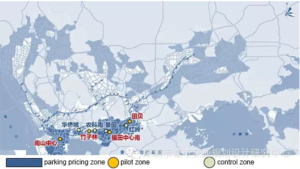
GIZ, the Shenzhen Urban Transport Planning Center (SZUTPC), and Shenzhen Municipal Commission of Transport (SZMCT) have jointly worked on reforming parking pricing in Shenzhen since 2013. International parking expert Paul Barter supported local transport planners to evaluate the effects of the parking price policy and assisted the project team in improving the actual policy design.
On-street parking management has been implemented in four pilot zones in the city center of Shenzhen since July 2014. After an operation period of several months, Shenzhen Urban Transport Planning Center (SUTPC) conducted an evaluation on impacts of the on-street parking management policy in Futian CBD, Nanshan CBD, Tianbei and Zhuzilin and published key findings of the evaluation report on the social media platform Wechat and local newspaper Shenzhen online.
Right before the evaluation started, four areas adjacent to the pilot zones with similar land use and parking problems have been identified as referential areas. Those areas are Futian CBD North, Science and Technology Park South, Agricultural Center South and Hongling. Ex-ante and ex-post parking surveys have been conducted both in pilot and control zones.
The evaluation results reveal that the overall street order and traffic movement benefit tremendously from the on-street parking pricing. In order to quantify the effects of on-street parking policy.
- The direct impact of regulating and pricing on-street parking is an increasing turnover rate. Long time parking can be shifted to off-street parking facilities with lower prices, which leads to more available on-street parking spaces for short time parking.
- The occupancy rate of off-street parking facilities generally increased by 22.3% on average. Especially the occupancy rate of weekday day time off-street parking greatly increased.
- As the newly established local parking management authority, the Shenzhen Road Management Center takes full responsibility of on-street parking management and enforcement. More than 600 wardens were hired to enhance the enforcement in the pilot zones. The results reveal that illegal on-street parking radically reduced. Especially illegal on-street parking during the weekday evening peak reduced by 92.36%.
- The dramatic decrease in illegal parking cleared the streets and quickly eased the congestion caused by illegal parking. The road capacity greatly increased and the traffic movement speed up.
- As a consequence of the improved traffic operation and increase in travel speed, the GHG emissions during the weekday evening peak reduced by 4.6%. At the same time, the GHG emissions slightly increased by 2.2% in control zones.